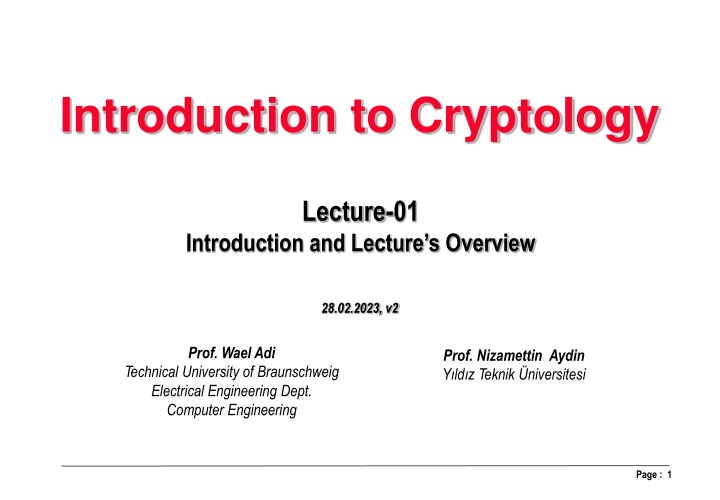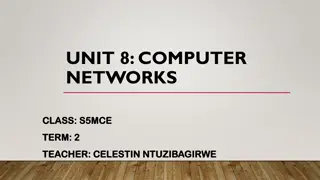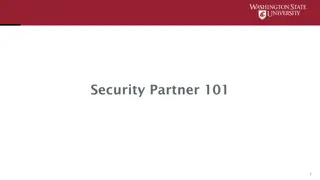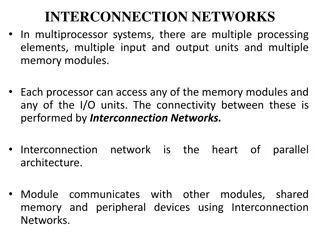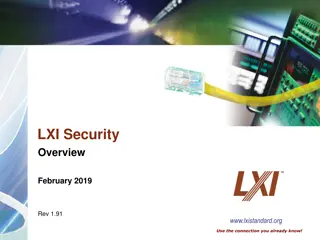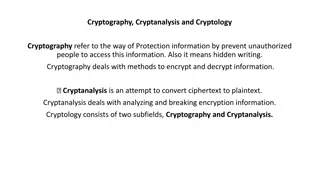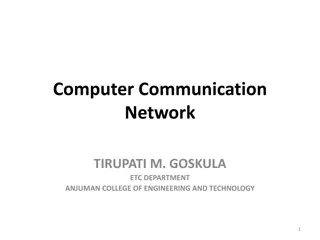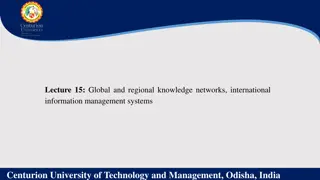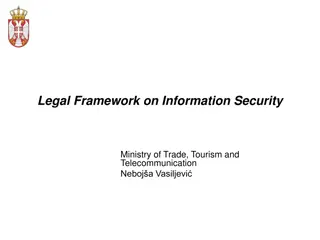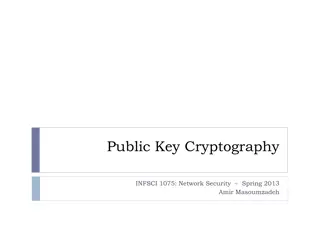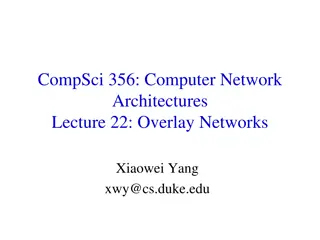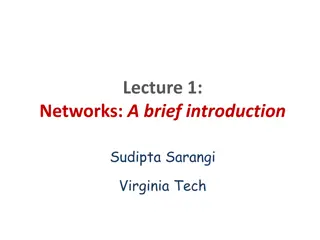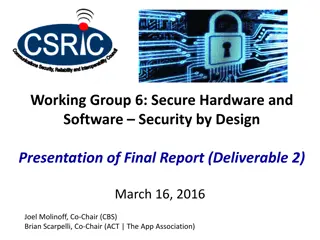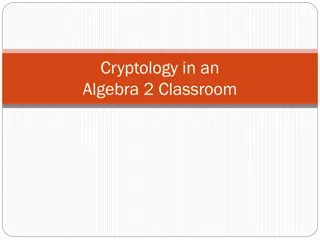Introduction to Cryptology: Exploring Security in Information Networks
This lecture introduces the fundamentals of cryptology, discussing the importance of security in information networks. It covers topics such as the evolution of security technology, the open world of information networks, communication network evolution, and the impacts of globalization on information technology. Recommended readings and resources are also provided to enhance understanding in this area.
Download Presentation

Please find below an Image/Link to download the presentation.
The content on the website is provided AS IS for your information and personal use only. It may not be sold, licensed, or shared on other websites without obtaining consent from the author.If you encounter any issues during the download, it is possible that the publisher has removed the file from their server.
You are allowed to download the files provided on this website for personal or commercial use, subject to the condition that they are used lawfully. All files are the property of their respective owners.
The content on the website is provided AS IS for your information and personal use only. It may not be sold, licensed, or shared on other websites without obtaining consent from the author.
E N D
Presentation Transcript
Introduction to Cryptology Lecture-01 Introduction and Lecture s Overview 28.02.2023, v2 Prof. Wael Adi Prof. Nizamettin Aydin Y ld z Teknik niversitesi Technical University of Braunschweig Electrical Engineering Dept. Computer Engineering Page : 1
Lecture Material - Lecture slides would be offered in Electronic form before the lecture- - It is highly recommended to make a printout of the slides to put your comments online on the printed paper slides. Possible Readings: 1. Cryptography: An Introduction https://www.cs.umd.edu/~waa/414-F11/IntroToCrypto.pdf By Nigel Smart (3rd Edition) Free on the Web. 2. Introduction to Modern Cryptography: Principles and Protocols J. Katz, Y. Lindell, CRC Press 2021 Recommend to download Recommended basic reference handbook: 3. Handbook of Applied Cryptography by Alfred J. Menezes, Paul C. Van Oorschot, Scott A. Vanstone CRC Press (October 16, 1996) (available free of charge on the WEB) - Homepage in Germany: https://www.tu-braunschweig.de/en/kns/faculty-and-staff/wael-adi Page : 2
Introduction This introduction presents few simple examples demonstrating main course contents with minimum mathematics ! Why Security ? The Evolution of Security Technology Overview on the course contents Page : 3
Why Security ? Open World of Information Network Evolution Over 6 000 Million mobile devices Widespread expanding worldwide network with unlimited applications in every day's life .. IoT.. etc. power-line CAN-Bus TV Global Information Short-Circuit Remote Control Car Wireless Network (AAA Scenario) Light Heating Internet Kitchen ... Garage Door Gates ... Anywhere Any time Any device Power Station power line network Page : 4
Evolution of Communication Networks PSTN, IP, 2G, 3G, 4G Mobile Network Architecture Circuit Network Circuit/ Signaling Gateway Mobility Manager Circuit Switch PSTN Public Switched Telephone Network IN Services Call Agent Voice IP Core Network Radio Access Control Packet Network (Internet) Packet Gateway Security threats are spread globally and worldwide over the whole network! 3G 5G 4G 2G-GSM 2G/2.5G Page : 5
Impacts of the Globalization of Information Technology ! Globalization (Borderless) Unlimited resources Unrestricted resources Easy untraceable access No national boarders/Law? Manageability ? controllability ? Abuse-ability Security is still a serious issue in most communication systems and is a very essential one !! Page : 6
Two Major Security Tasks Authentication Securely identify network entities Secrecy Keep data secret against illegal users Security tasks require to deploy cryptographic mechanisms Cryptography: deals with securely hiding and identifying information and entities Page : 7
Major lecture contents - Mathematics for cryptography. Number Theory (4) - Secrecy Theory (1) - Secret-Key Cryptography (2) - Public-Key Cryptography (5) - Cryptographic Protocols and Schems (1) - Physical Security and Identification (1) The contents are design and engineering-oriented with Less or no proofs, Page : 8
1. Secret-Key Cryptography Overview Concepts Page : 9
Secret Key Cryptography (Symmetric System) K-open = K-close Mostly the same key - Open and close using shared secret keys (mostly one shared key) !! - A Secret key agreement is required ! Page : 10
Secret Key Crypto-System : mechanical simulation SENDER Public Lock RECEIVER Key = Z Secret key agreement Key = Z Z Message Message Lock Z Page : 11
Conventional Cryptography till 1976 : Secret Key systems Known locks as Standard Ciphers Ciphering De-Ciphering Sender Receiver Y = E (Z,X) X X E ( Z,X ) D ( Z,Y ) Message Message Channel Z Z Secret Key Channel Security rests on the Cipher Secret Key = Z Page : 12
2. Public-Key Cryptography Scientific Breakthrough 1976 Secure-Communication without prior shared secret keyes Page : 13
Public-Key Secrecy Systems K-open K-secret - Open and close with different keys!! - No Secret Key Agreement required Two Major Schemes in Public Key Cryptography: Diffie-Hellman Public Key exchange scheme RSA public Key secrecy system Page : 14
Sharing Secrets without prior exchange of secrets Public-Key Cryptography Breakthrough 1976 (Diffie & Hellman) Mechanical Scenario Open Register A B Secret key-B Secret key-A SHIELD ! Same thing ! Shared Secret Page : 15
Example for Diffie-Hellman key exchange scheme 1976 Widely use in internet, banking etc... Open Agreement and Register Shielding function is: y = (5 x) mod 7 A B 5 5= 3 5 3= 6 K-open-B= 3 K-open-A= 6 Secret key-B= 5 Secret key-A= 3 5 3 5 5 6 3 3 ( ) ( ) 5 5 5 5 3 Shield ! same thing ! Z = 6 5 5.3 5 3.5 Page : 16
Basic Public Key Secrecy System (RSA system1978) (Mechanical simulation: user B gets a secured message from A) User A User B Public register Ko= Kc-1 Close Kc Kc open ( )Kc(mod m) M MKc.Ko= M Ko MKc (MKc)Ko Page : 17
3. Authentication Identification, Signature .. Page : 18
Secured Identity (Authentic Entities) International Mobile Equipment Identity IMEI (non-secured) Subscriber Identity Module SIM (secured) Page : 19
GSM Authentication: Challenge-Response Subscriber Identification Mechanism Mobil-Station Verifier-Station Identity key max. 128 Bit Random Generator RAND 128 bits RAND Ki Authentication request Ki RAND A3/COMP128 A3/COMP128 32 Bit ^Mapping function XRES XRES = Authentication response XRES SIM Card Authentication Result. Accept or reject Page : 20
Secured Signature (Data Authentication) (source authentication) Signing Process: Checking Signature : Signing key Document Data Signature Data Authentic Signature Generator Signature Checker Checking key Data Signature Accept/reject document Signed Document Only designated person can sign! Everybody can check the signature! Page : 21
4. Cryptographic Protocols Secret Sharing, Security Management, Standards, Mobile Security & Applications Page : 22
A sample Cryptographic Protocol No Key Cryptography : Shamir s 3-Pass Protocol (Mechanical scenario) User A User B Pass 1 B A Pass 2 Pass 3 A Page : 23
5. Physical Security DNA-like Identity for Physical Units - Unclonable Physical Units (PUFs) - Clone-Resistant Physical Units Page : 24
Unclonable physical Identity: the born DNA-like as provable identity Biological DNA Image:RNA-codons.png Select Markers Chemical Extractor Chemical Markers Bio DNA > 248combinations 3 1012 Identification by matching markers Biological DNA Identification: A Unclonable if the DNA-chain , then it is unclonable as it is not possible to store or simulate B D C Extract same marker site Non-equal marker extracts for different entities A B C D B D A C Page : 25
Electronic born DNA-like identification PUF: Physically Unclonable Functions (off-shelf unit) Discrete Identification Response Discrete stimulation (select marker) Analogue Response Discrete Extractor Physical Unclonable Functions PUFs offer DNA like Identification Properties PUFs are: Born unpredictable and unclonable physical VLSI properties. In other words: PUFs are physical non-linear, upredictable huge mappings (impossible to model or simulate) in a semiconductor VLSI device Page : 26
Course objectives The aims of this course is to give a basic understanding of the design fundamentals and tools used in modern information security systems Some contemporary standards would be introduced to enhance technical and practical understanding Course strategy: less proofs, more practical design hints targeting to offer security engineering skills! The course start with introducing basic mathematics for cryptography Page : 27
